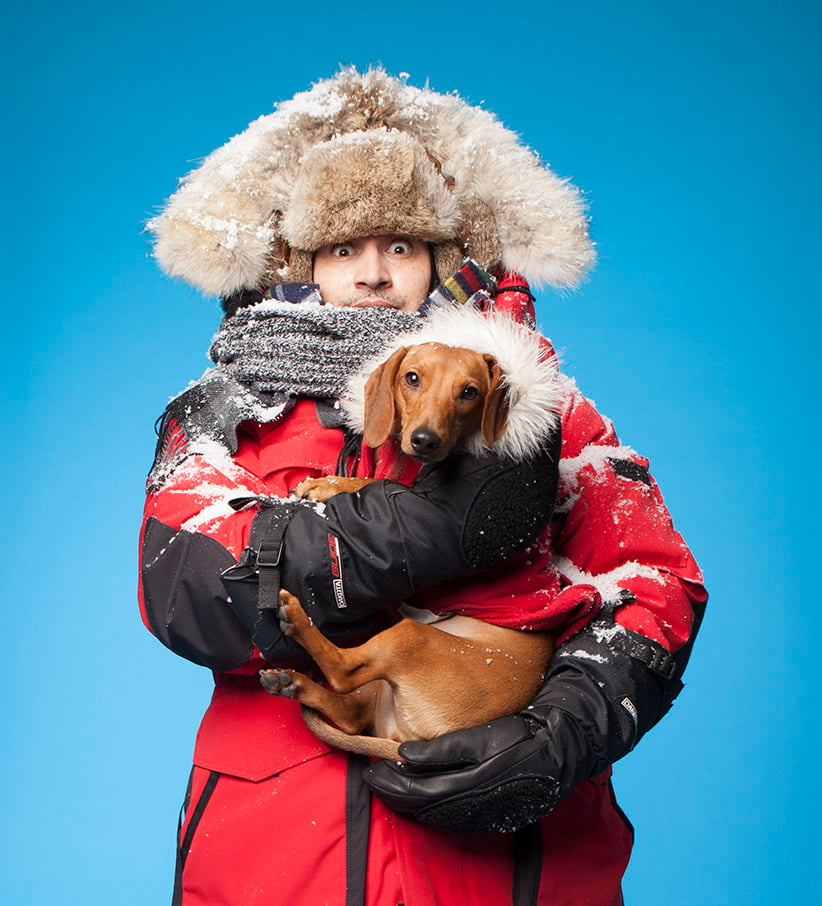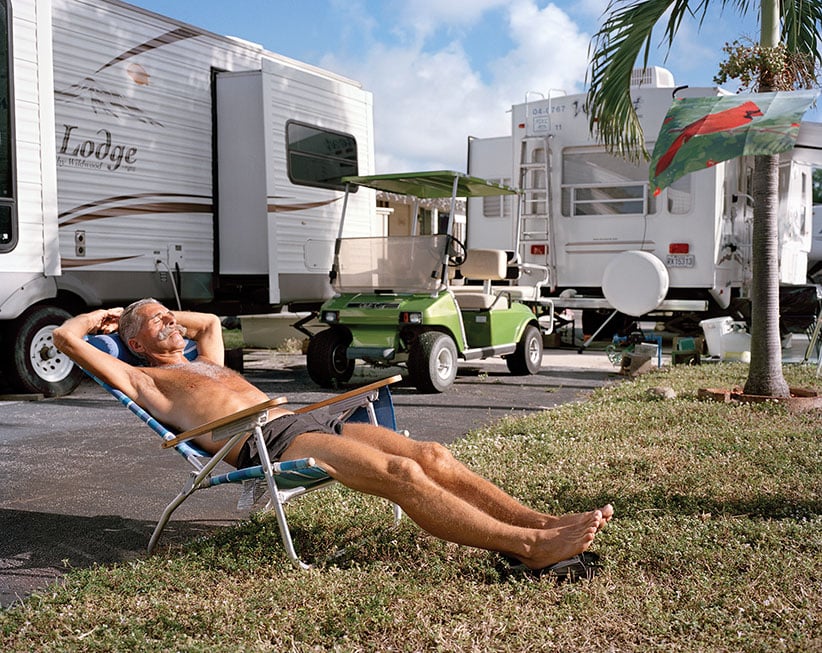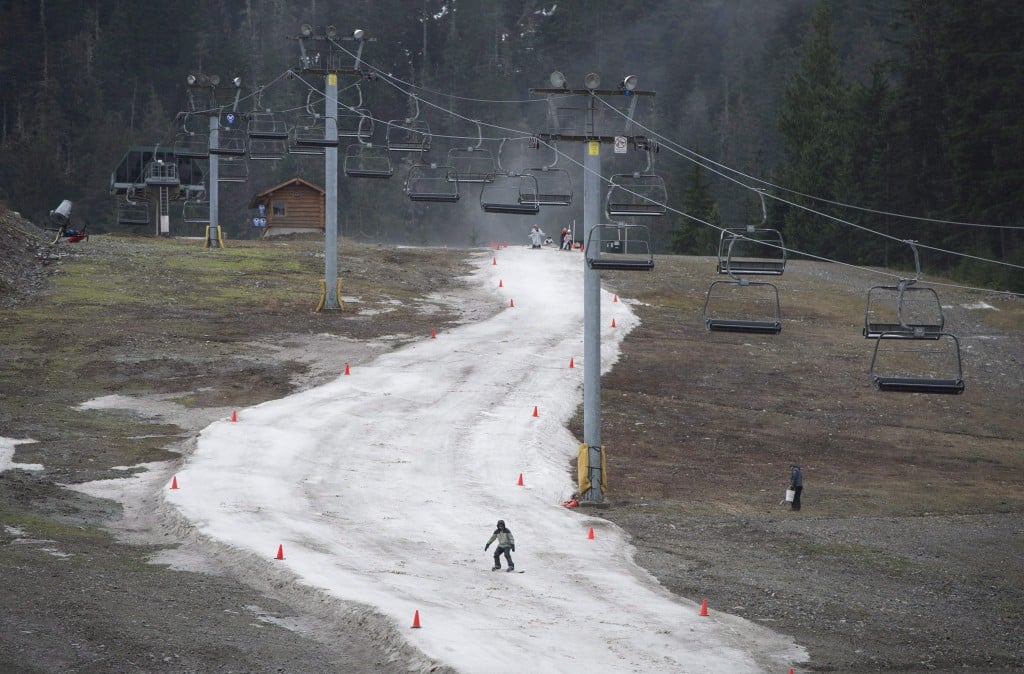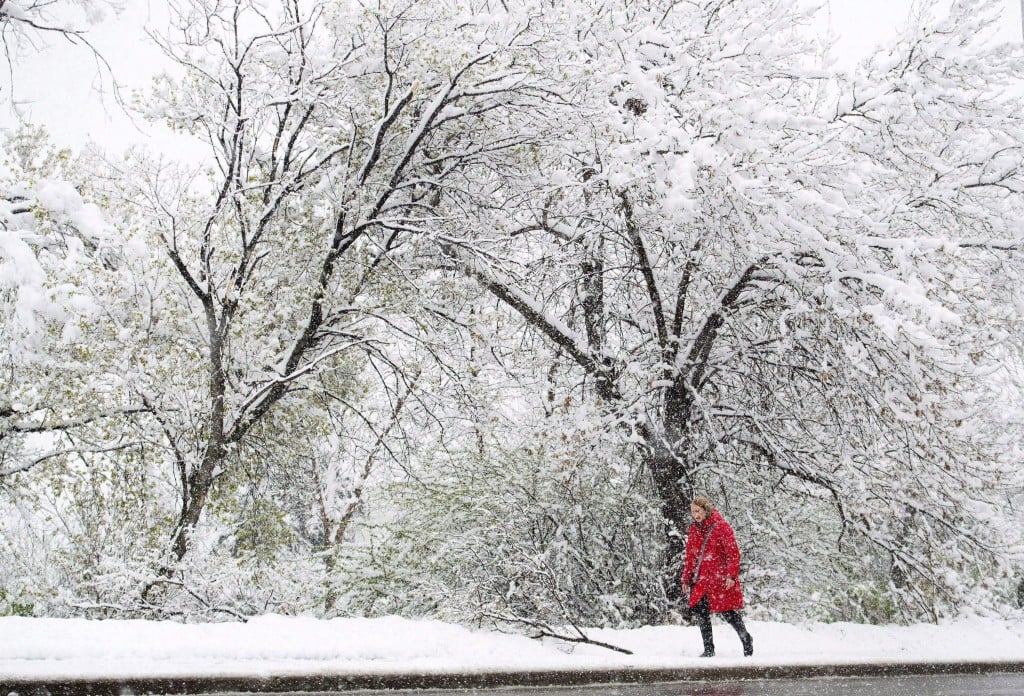Canada: A nation of winter wusses
Canada used to pride itself on being the land of ice and snow. Now we avoid the outdoors—even when it’s not all that cold.
Winter wussie. (Photograph by May Truong)
Share

Despite an unseasonably warm winter and a forecast calling for a low of 7° C, Rhéal Leroux is ready for his annual trip to Florida. “Today is cold for me,” he says from his suburban Ottawa home. “It’s 28 in West Palm Beach.”
So on a late-November weekend—the same weekend on which he’s fled for the past 10 years—the 65-year-old was on a plane south, where he can play golf and walk outside without fear of slipping. Aside from a short visit home for a couple of days, Leroux won’t be back until April. There’s little that would make him stick it out in the cold Canadian winter. “You need two jackets to walk outside and you’ll still freeze,” he says. “Not being a skater or a skier, what can you do?”
In Canada, complaining about the cold is a national pastime. But what makes Leroux’s attitude noteworthy is that he’s the man who, back in 1978, came up with the idea for Winterlude, Ottawa’s annual outdoor festival that celebrates all things snowy and icy. As it turns out, even the self-described “father of Winterlude” hates the winter.
Canada’s mighty winters once invoked a sense of pride and superiority, a way to distinguish Canadians from Americans. “For we are a northern people, as the true out-crop of human nature, more manly, more real than the weak marrow-bones superstition of the effeminate south,” wrote the lawyer and essayist William Alexander Foster in his 1871 address, “Canada first or, our new nationality.”
For centuries, Canadians wouldn’t let a little cold stop them. Days after Christmas in 1794, the Hudson Bay Co.’s Peter Fidler—a British surveyor, though perhaps Canada’s first weatherman—ventured out to record at what temperature liquor froze. (For the record: Holland gin freezes solid at -27° C, English brandy at -32° C and rum at -35° C.)
Canadians continued to brave the elements for generations. Not even a power outage during the 1956 ice storm in P.E.I. could stop Tryon Consolidated School from educating its charges; it could still be kept warm with a wood stove. Cape Traverse local Joe MacDonald was so adamant about getting his two kids to class that he carried them, one child under each arm, as he skated to school.
Times have changed. Environment Canada issues twice as many types of winter warnings as it did 25 years ago. School cancellations are on the rise. Dressing warm—from temperature-rated parkas to lab-tested winter boots—has never been more in fashion, and yet major cities and university campuses continue to expand underground walkways so locals can avoid the cold, no matter the cost. P.E.I. native Meaghan Blanchard rose to local stardom last month with almost 200,000 YouTube hits for her song I’m Not Ready to Scrape Ice, a parody of the Dixie Chicks hit, Not Ready to Make Nice.

Winter aversion is practically endemic, despite the fact that virtually every Canadian city has not only warmed appreciably but also experienced less snow over the past few decades. Leroux is not exactly the only Canadian with a tee-off time. Snowbirds are flocking to Florida; 41 per cent of U.S. homes bought by Canadians last year were in the Sunshine State, according to the National Association of Realtors.
The rapid decline of the Canadian dollar has done little to dissuade Canucks from making the trip south, according to Jennifer Hendry, senior research associate with the Canadian Tourism Research Institute. When she analyzed StatsCan data regarding trip intentions for the winter, numbers were indeed down, “but not to the extent that we expected,” she says. Instead, people are modifying their vacations rather than cancelling them outright. Forget the fancy hotel; an accommodation with fewer stars won’t hurt. Who needs fine dining when there’s Applebee’s? Instead of a 10-day stay, a shortened six-day trip will do. “It’s almost a feeling of ‘as long as I can put food on the table, I’m going to travel this winter,’ ” Hendry says.
As for pride, Toronto lost much of that in 1999 when then-mayor Mel Lastman—founder of the Bad Boy furniture chain, no less—called in the Army to help shovel snow during a blizzard. The bar to get Canadians outdoors is now set so low that even the David Suzuki Foundation’s “Winter Family Challenge,” launched in January 2015, asked people to get outside as a family just once a week.
“We have hot summers and resplendent autumns,” wrote the late Governor General Literary Award-winning novelist Robertson Davies, “but it is winter that establishes the character of our country and our psychology.” If what Davies wrote is true, then Canada is—frankly—turning into a nation of winter wusses.

Simaga Lyta, an Iqaluit mother, is pushing back. She was upset last March when the school board decided to cancel school. After all, it was only supposed to get down to -50 with the wind chill. “If I’m going to teach my son, for example, to hunt, I don’t want him to think it’s too cold out, he can’t hunt,” she told local media. “And if he does go out hunting on a beautiful day and it does get cold, I want him to know how to survive.” Cancelling classes because of the cold, she argued, was harming Inuit culture, and it marked eight days of cancellations to that point in the school year due to weather.
While the mere thought of -50 would put a chill in most Canadians’ bones, some school boards and parents are struggling with snow days piling up. In Pictou County, N.S., for example, there was an annual average of 4.4 winter-storm-day cancellations between 1978 and 1988, according to a 2009 report. The following decade, that average jumped to 5.2 days. From 1998 to 2008, the annual average increased again to 6.9 days of classes missed due to winter weather.
“Over those years, the expectations of families have changed,” says James Gunn, the author of the report, who has previous experience as a principal and superintendent in the province. “Their tolerance of what makes a bad day is not what it used to be.”
Back in the day, road conditions had to be significantly worse before anyone even thought of cancelling school, Gunn adds. He remembers being a rural high school student in the early 1960s, helping put chains on the school bus and affixing it to a farmer’s tractor to help pull the bus up a snowy hill. “That would never happen now,” he says.
While bus cancellations don’t automatically mean school doors will be shuttered, many teachers aren’t keen to drive in on snowy days either. The Elementary Teachers’ Federation of Ontario, for example, voted in 2014 to recommend that school boards cancel classes whenever bus service is cancelled.
In New Brunswick, some schools lost 13 days of classes last year because of the harsh winter. “Thirteen days cancelled, plus seven more professional development days, plus statutory holidays, plus one or two weeks in March,” tallies Paul Bennett, director of the Halifax-based education policy analysis firm Schoolhouse Consulting. “Who can work when your kids are out of school [this much]?”
Cancelling school not only puts extra pressure on families with two working parents, but it also writes off certain lesson plans for students or forces teachers to cram more into a limited time frame.
But if the medium is the message, school boards are woefully underprepared to get work to students on snow days. “The school boards here have become very effective at communicating electronically that school is cancelled,” says Bennett. “But they can’t seem to organize e-learning during those days kids are not in school.”
Bennett suggests schools prepare “blizzard bags”—filled with various homework for students with or without access to a computer at home—for days when poor weather forces school closures. It’s a practice already in place at many schools across Ohio, New Hampshire and Massachusetts and could prove a vacation-saver up north. When Nova Scotia’s education minister floated the idea of students coming in during March break to make up class time, parents complained it would ruin family trips. The premier stepped in to assure parents the government wouldn’t enforce such an option, and asked school boards to sort it out.

David Phillips figured he had a “good news” story on his hands about 10 years ago when he crunched the numbers and found out Canada was no longer the coldest country in the world. The fall in the rankings had nothing to do with global warning, but rather the breakup of the Soviet Union, which changed some boundaries and pushed the Russian Federation to top spot. The senior climatologist with Environment Canada issued a press release, but he was surprised by how Canadians reacted. “It was looked upon as sad news,” Phillips says. “We think we’re the land of ice and snow.”
But data shows that’s becoming less the case. Since 1948, winter has warmed by three degrees nationally, an increase greater than any other season. In the 40 years between 1960-99, Montreal averaged more than 15 days a year with temperatures dipping to -20° C or colder. Since the turn of the century, the city has barely registered 10 of those days on average each year.
Comparing two overlapping sets of 30-year temperature normals (1961-90 and 1981-2010) from Canada’s National Climate Data and Information Archive for the winter months of every provincial and territorial capital, only Iqaluit has gotten colder. Whitehorse and Yellowknife winters are nearly 2.5° C warmer than they once were, while winter days in Regina, Edmonton and Winnipeg are on average about 1.5° C warmer. “These changes appear to be very small, but they’re not,” says Adam Fenech, director of the Climate Lab at the University of Prince Edward Island, who examined the data. “It’s a slow-moving window.”
Snowfall has also decreased across the majority of Canadian cities, most notably in Vancouver, where snowfall normals fell by 31 per cent from the 1961-90 average to the 1981-2010 average. There may be the occasional bad year of snowstorms, but the 30-year window of study limits the effect of those anomalies. Locals in Fredericton, Halifax, Charlottetown and Toronto might not believe it, but snowfall has dropped in each of those cities, too, by about 15 per cent.
Winnipeg, meanwhile, may be so cold that when NASA named a small part of Mars after the city, it was considered an emblem of pride. But if a tough winter day in the Prairies constitutes, say, at least five centimetres of snowfall and a minimum temperature at or below -20° C, “Winterpeg” averaged 2.7 tough winter days annually in the 1950s, but saw only 1.3 per year since the turn of the century. Regina, too, fell from having an annual average of 1.6 tough winter days during the 1950s to 0.6 since 2000. So when parents, or grandparents, say Canadian winters aren’t half as bad they used to be, they’re correct.
If anything is getting worse, it’s the made-up terms to describe the impending doom of the season: “snowmaggedon” or “snowpocalypse” are two that come to mind. (Kansas City wins the award for most creative with “the Blizzard of Oz.”) “We rush to the thesaurus or invent Hollywood-like names and apply them to weather terminology,” says Phillips. “But they have traction. People remember them and use them—and it sometimes scares the bejesus out of people.”
Environment Canada too has more types of winter warnings than ever before—a byproduct of improved weather reporting accuracy and Canada’s insatiable desire for weather news. In 1949, for example, winter warnings issued by Environment Canada included blizzard, frost, heavy snowfall, freezing rain and wind. Not even extreme cold warranted a notice. Today, there are more than twice as many types of winter warnings: Arctic outflow, blowing snow, extreme cold (including wind chill), flash freeze, freezing drizzle, snowfall, snow squall, and winter storm. “We’ve invented more weather, when there is no new weather,” Phillips says. “We just have more terminology and descriptors.”
There are few winter terms more influential, however, than “wind chill”—which as it happens was invented by an American—as 82 per cent of Canadians make decisions based on wind chill, according to a recent study. “Most meteorologists hate wind chill because it’s not a perfect measure of coldness, but Canadians love it because it really exaggerates the worst,” Phillips says. Which means if it’s -25° C outside, but minus -35 with wind chill, “by the end of the day, people are saying it’s -35 outside.” Anything to make it sound more spectacularly cold than it really is.
Brag as we might about the cold, the local economy suffers when people cancel restaurant reservations or forgo a day of shopping because the wind chill drops too low. Retailers, tourist operators and restaurants suffered in 2014 when consumers “preferred to hibernate instead of venturing out,” wrote Scotiabank’s deputy chief economist Aron Gampel. TD, meanwhile, blamed oil prices and the cold weather for the GDP dropping 0.7 per cent in the first quarter of 2015.
If Canadians ventured outside more, they’d find out it often doesn’t feel as cold as the weatherman claims. “One of the unknowns about meteorology is we measure temperature in the shade, not the sun,” Phillips says. So if the wind isn’t blowing and you want outdoors to feel seven or eight degrees warmer than what you heard on the radio, Phillips has one piece of advice: “Walk on the sunny side of the street.”

Prior to the 2014 Sochi Olympics, the Canadian Olympic Committee launched a massive marketing campaign with the tag line: “We are winter.” While Canada can trumpet our double gold medals in hockey, off the ice Russians don’t fear winter like Canadians do. Withstanding the cold is part of their history; Russians fought off invasions from Napoleon Bonaparte and Adolf Hitler, whose troops both succumbed to Russian winters. Every Jan. 19, thousands of Russians dive into icy waters as part of an Orthodox Church tradition to symbolically wash off their sins. Some go swimming in the winter waters every day as part of “walrus clubs.”
Norwegians, too, look forward to winter. “It’s easy to love the winter in northern Norway,” says Kari Leibowitz, a Ph.D. student at Stanford University who spent a year at the University of Tromsø, the world’s northernmost university, to study winter attitudes. It’s quite a statement coming from Leibowitz, a New Jersey native who hated winter so much growing up that she moved to the southern U.S. after high school.
When Leibowitz opted to go to Tromsø—a city as far north as Tuktoyaktuk, N.W.T.—“I originally went there to study why people weren’t more depressed,” she says. When she arrived in August 2014, she began asking locals about the cold months ahead, when the sun barely rises for two months. Norwegians responded by saying it was either a) not a big deal, or b) they looked forward to the winter. The town of 70,000 has a cross-country ski track around the island, fully lit, so everyone can ski with ease. People eat outside at restaurants, with blankets and under heat lamps. New mothers are out with their strollers pushing newborns who are wrapped as if they’re in a cocoon.
Getting a daily dose of outdoor sun in the wintertime—even if it’s just a half-hour’s worth—could be helpful with regulating hormones that affect our mood, such as melatonin, says Kate Harkness, a professor of psychology at Queen’s University. “People who get into their underground parking lot, drive to another underground parking lot, and spend the whole day inside are not getting the critical sunlight they need.”
According to a 2015 survey commissioned by the Weather Network, 43 per cent of Canadians experience “winter blues”—a mild form of seasonal affective disorder—while the Canadian Mental Health Association says that percentage is closer to 15 per cent. “The more you talk about it being miserable in the winter, the less likely you are to go outside,” Harkness says. This, in turn, will negatively affect mood. “It becomes a self-fulfilling prophecy.” One way to help change that is to go outside for a little walk—even if it’s cloudy.

Complain as we might, Canadians have never been better equipped to deal with the cold, from Sorel boots that can handle temperatures of -40° C to winter footwear from Pajar with cleats built into the sole for a better grip. Footwear is now a science: WinterLab in Toronto recreates harsh winter conditions—from icy surfaces to 30 km/h winds—to test different treads.
Even winter apparel is having its fashion moment. Total outerwear sales across Canada jumped by 11 per cent to $3.2 billion in the 12 months leading up to September 2015, according to market research firm NPD Group. The previous 12-month cycle had growth of five per cent. “It’s cool to have technical hardware on your fashion outerwear for everyday use,” says NPD’s fashion industry analyst Sandy Silva. “You’ll never use the true utility the purchase was intended for an everyday occasion.” Ravean, a Utah-based startup, just launched a line of fashionable battery-heated jackets with gloves that can be heated, too, by plugging them into the coat.
But the company that comes top of mind each winter is Canada Goose, whose parkas are advertised as being “field tested in the coldest places on Earth.” Its domestic sales increased in 2015 by more than 25 per cent over 2014, according to figures shared by the private company, with British Columbia, Ontario and Quebec its biggest growth markets. The jackets are so in style that Sports Illustrated featured supermodel Kate Upton on the cover of its swimsuit issue wearing only a Canada Goose parka and bikini bottoms. The coyote-fur-trimmed hoods have, on their own, almost made wearing fur acceptable again. From an annual revenue of $5 million in 2001, the company forecasts global revenues will top $300 million this year—which might explain the opening of a second factory in Winnipeg.
Back in Tromsø, there’s always something to look forward to in winter. When the local Christmas markets shut down, the town prepares to host an international film festival in January. “It’s the coldest, darkest part of the year and yet they’re inviting people from all over the world to come to their film festival,” Leibowitz says.
As for her research, Leibowitz helped develop a wintertime mindset scale that surveyed people’s agreement or disagreement with statements like: “There are many things to enjoy about the winter,” or, “In the winter, I feel like doing nothing.” “We found that having a positive wintertime mindset was correlated with life satisfaction, personal growth and positive emotions,” she says. “All seasons have positive and negative aspects, but we tend to focus on the positive things about summer and the negative things about winter.”
She isn’t suggesting that those with clinically diagnosed seasonal depression can simply snap out of it by changing their mindsets. But for many cold-weather haters, reframing the idea of winter can be beneficial. She’s seen it first-hand, like when she hunkered inside at 10 p.m. during Tromsø’s worst snowstorm of the year. “I looked outside and saw someone on my street,” she laughs, “just going for a jog.”

The myth about Edmonton winters is that it’s six months of -40° C. Untrue as it is, that’s the way the city is built. “We’ve written off the outdoors of Edmonton in the wintertime,” says city councillor Ben Henderson. “There was a movement in the ’70s and ’80s that if we moved everything indoors, we could somehow make the winter go away.” Emblematic of the movement was the 5.3-million-sq.-foot West Edmonton Mall, which first opened in 1981. It now has more than 800 stores and 200-plus restaurants in addition to its waterpark, skating rink and a IMAX 3D movie theatre—everything a family needs for a day of entertainment, without the cold.
What happened to the City of Champions, where more than 57,000 fans once braved -20° C weather (colder with the wind chill) for the 2003 NHL Heritage Classic? Many of them are underground in the city’s 13-km indoor pedway system, which is primed for a major expansion. (Toronto boasts it has the Guinness World Record for the largest underground shopping complex, spanning 30 km, which connects subways and downtown offices.) “There are these gorgeous winter days people are convinced didn’t happen,” Henderson says. “We had no capacity to take advantage of them.” Which is why Henderson is on a mission to help people appreciate the joys of winter.
Edmonton is entering its third year of a “Winter City Strategy” to get locals outside in the colder months, including supporting a four-season patio culture. The area surrounding the Edmonton Oilers hockey arena is now known as the “Ice District,” a rebranding to make the city proud of its cold. The 40 Below Project, an Alberta-based initiative that releases anthologies of poems, short stories and artwork that promote the joys of winter, recently released a second volume.
Related: How Edmonton is wrapping its civic identity in the Oilers
“Look back 30 or 40 years. There was a lot of stuff happening, and some of people’s fondest memories were in the wintertime,” Henderson says. “Mukluk Mardi Gras is one that every child who grew up in Edmonton remembers vividly.” The beloved winter carnival, which took place throughout the ’60s, included a snow parade down Jasper Avenue, dogsled races and cross-country toboggan races. “Ironically,” Henderson adds, “it fell prey to the fact that the weather was too warm.”
So while a 2007 survey from Statistics Canada found 27 per cent of new Canadians named Canada’s climate as what they disliked most about their new country, perhaps that’s partly attributed to a perceived lack of things to do. “Some of the people who jumped on the bandwagon early were our newest immigrants,” Henderson says of Edmonton’s Winter City initiatives. “They were fascinated by winter and wanted to be more engaged to find ways to enjoy it.”
With an original budget of $200,000, Rhéal Leroux had enough to entice tens of thousands of locals and tourists to the inaugural Ottawa Winterlude in 1979. There were professional ice sculptures, an outdoor winter playground for kids, not to mention thousands skating on the Rideau Canal. A group of young skaters were on hand to race a horse ridden by hockey legend Bobby Hull. Prime minister Pierre Elliott Trudeau attended with his kids; his seven-year-old son, Justin, got to pet the horses.
Leroux says he’s proud of all that the festival has accomplished for the city, including watching the success of BeaverTails, which went from selling pastries at a kiosk in Ottawa in 1978 to becoming a national emblem, as Leroux puts it. But if he has one regret, it’s that Winterlude started to put some of its attractions indoors, such as musical programs and beer festivals. “That was not the basic philosophy at the beginning,” he says. “If we create an event to promote winter, let’s promote winter.”